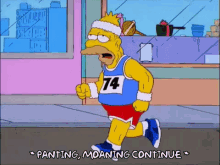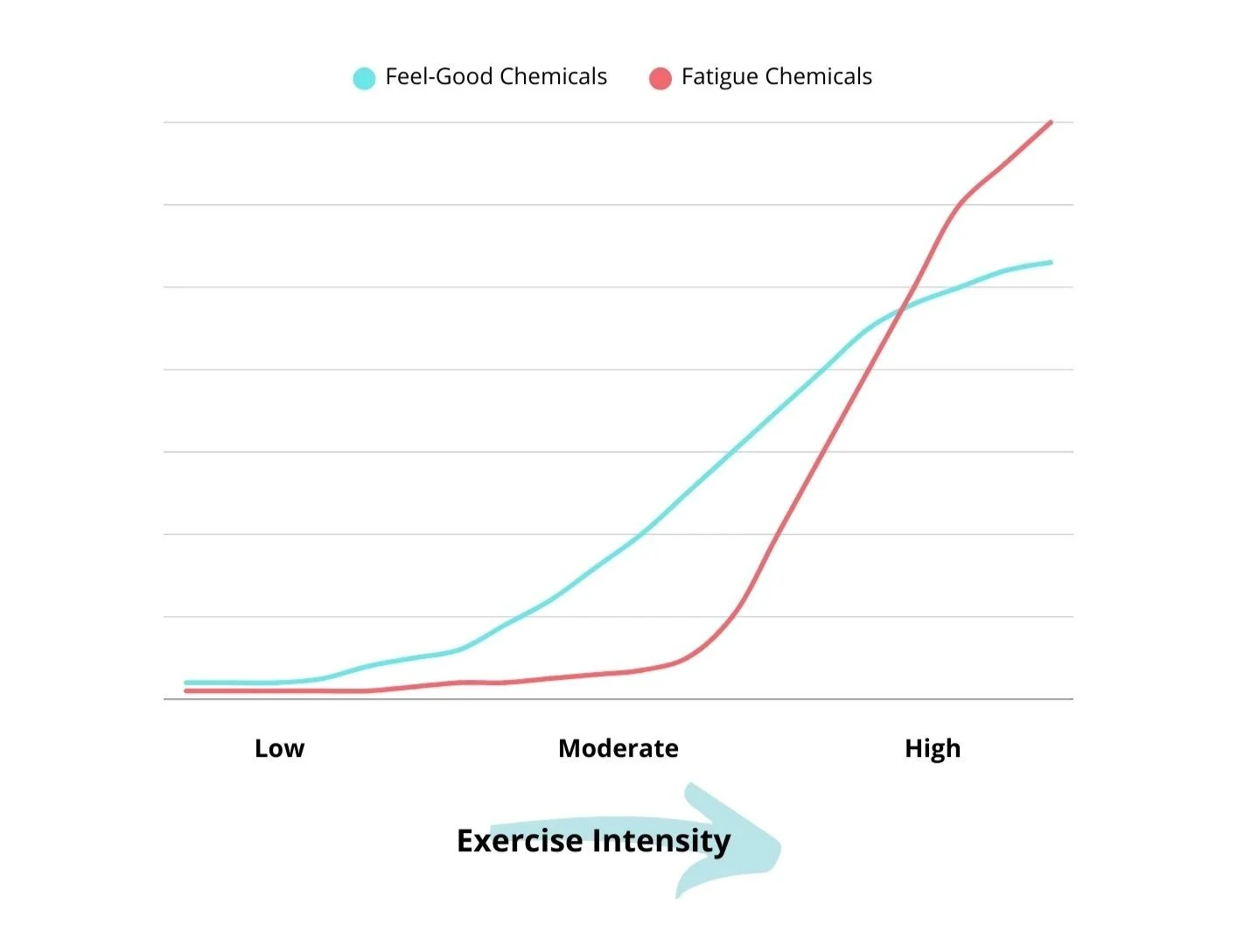How Hard Should You Exercise If Your Goal Is To Support Your Mental Health?
The fitness industry is obsessed with intensity, especially high intensity. It’s all “no pain no gain”, and “pain is weakness leaving the body”… Spend just a few minutes scrolling through fitness content and you’ll see plenty of advice to do high intensity interval training and workouts that push you to their limits.
Intensity does matter, but the relationship between exercise intensity and well-being is nuanced, especially when your goal is to support your mental health. Understanding this complexity and finding the right balance for yourself is incredibly important.
This article explains what exercise intensity means, how it’s related to the mental health benefits of exercise, and how you can find the exercise intensity that best supports your mental health.
What Is Exercise Intensity?
Exercise intensity refers to how hard you’re working during your sessions.
Cardio Intensity
Cardio intensity is often divided into heart rate zones, but for simplicity, I’ll talk about three basic levels: light, moderate (or medium), and vigorous (or high).
During cardio exercise, we use heart rate and breathing to measure intensity. A simple way to tell which intensity you’re at is to use the “talk test”.
Light intensity cardio doesn’t increase heart rate or breathing significantly. According to the talk test, you’re at light intensity if you can speak normally and would have no problem singing.
At moderate intensity, your heart rate and breathing are noticeably elevated. Using the talk test, you’re at moderate intensity if you can speak in full sentences but you would be too out of breath to sing.
Vigorous intensity is when your heart rate is very elevated and you’re breathing so hard that you can only speak a word or two at a time.
Strength Training Intensity
Strength training intensity is measured by how close you get to your maximum effort. Below is a strength training effort scale that I often use with clients. This scale ranges from 1-10, where 1 is a very light effort and 10 is an absolute maximum effort.
A 10 out of 10 effort is feels like you’re pushing or pulling a weight as hard as you can, but it just won’t move. That’s also known as “muscular failure”.
To gauge effort, we estimate how many more reps you can do with good form at the end of a set.
9 out of 10 effort: at the end of your set you feel like you could maybe do one more repetition with good form, but no more than that.
8 out of 10 effort: you end your set feeling like you could do two more good form repetitions.
7 out of 10 effort: you feel like you could do three more good form repetitions at the end of your set.
We consider 9 or 10 out of 10 to be vigorous intensity, 7 or 8 as moderate, and 6 or below as light intensity.
If you’ve never tried to estimate your strength training effort before, I highly recommend you start practicing this skill. You’ll get better and more accurate with practice.
What Does The Research Say About Exercise Intensity and Mental Health?
There’s decades of research showing that both moderate and vigorous intensity exercise can improve physical and mental health. That research forms the basis of the 2018 Physical Activity Guidelines For Americans and also the 2020 World Health Organization Guidelines on Physical Activity and Sedentary Behavior.
Any kind of movement is valuable, so if light exercise is all you can currently do, that’s still much better than nothing.
But I strongly encourage you to aim for at least moderate intensity as often as you can.
There’s some evidence that higher intensity exercise may be even more effective than moderate intensity when it comes to improving brain health and reducing symptoms of depression and anxiety.
For example, a 2024 meta analysis on the effects of exercise on depressive symptoms found that vigorous intensity exercise was more effective at reducing symptoms than lower intensities. Studies on high intensity exercise have found that it releases more BDNF, a protein that protects and repairs brain cells.
This makes sense if we think about exercise as way to stimulate the brain to change. When we challenge our brain (and our body) with hard exercise, it responds by adapting so it can handle that type of exercise in the future. Pushing harder, as long as it’s safe and appropriate, gives the brain a bigger signal to improve.
To learn more: How Exercise Makes Your Brain Work Better
How Intensity Affects Your Exercise Experience
I’ll admit that vigorous intensity exercise, while effective, isn’t always enjoyable.
In fact, exercise intensity is a major factor in whether your workout feels pleasant and motivating, or whether it’s so unpleasant and grueling that you hate every second of it and vow to never do it again.
Even the most effective, perfectly designed workout is useless if you don’t do it, so it’s important to find ways to exercise that make you feel good. Exercising at the right intensity for you is a big part of that.
To understand how exercise intensity affects the way you feel, we need to know a little about the chemicals that are released in your brain and body during exercise. I’ll keep this simple, I promise.
During exercise, there are a variety of neurochemicals that are released. Some of them come from your muscles and travel up to your brain and some are released in your brain itself. Those include myokines, neurotransmitters, endorphins, endocannabinoids, and neurotrophic factors.
Some of those chemicals boost your mood and make you feel good, others help different parts of your brain communicate better, and others create long-term changes in your brain that help decrease symptoms of anxiety and depression and decrease your risk of cognitive decline and disease. Exercise really is incredible!
The release of those chemicals is related to exercise intensity. The harder you work, the more brain boosting chemicals are released. That’s great, but there’s a catch.
As exercise intensity increases, your muscles also release other chemicals that don’t feel so good. Lactic acid is probably the most well-known of these, but there are many others. At the same time, fatigue signals start coming into your brain from your body, letting your brain know that you’re running low on fuel or that a lot of force is moving through your joints.
Your brain takes that information and, if it senses that you’re not going to be able to maintain that intensity, it starts making you feel tired so you want to stop.
In the graph below, I’ve lumped the beneficial, brain boosting chemicals together and labeled that line “Feel-Good Chemicals” and I’ve lumped the fatigue-inducing chemicals and signals together and labeled them “Fatigue Chemicals”.
When the happy chemicals outweigh the fatigue signals, you mostly feel good and perceive the workout as being pleasant and enjoyable. You also get a noticeable increase in your mood and feel good about yourself and your abilities, which can boost your mental health. That’s what we want.
When the fatigue chemicals take over, the happy chemicals are still there helping your brain get healthier, but you don’t feel them as strongly. Instead, it’s like the fatigue chemicals throw a blanket over everything and you just feel exhausted.
Some people are able to tolerate high intensity exercise and still feel good. There are a lot of factors at play there, and I’m not going to get into them in this article. But please know that, if you’re someone who struggles with high intensity exercise, you can train your mind and body to get more comfortable with it over time.
Finding The Right Exercise Intensity For You
Let’s be honest, motivating yourself to do hard exercise is tough. That’s especially true if you’re dealing with a mental health issue or if you’re not the kind of person who loves grueling exercise.
I recommend sticking with the exercise intensity that feels the best for you in the moment. That will help you build a positive association with exercise, increase your confidence, change your self-identity, and keep you motivated to do it again.
For most people, that’s moderate intensity exercise, but your individual preferences and abilities may vary. Aim for the intensity that maximizes those feel-good chemicals but isn’t so high that the unpleasant chemicals take over.
You can experiment with this by gradually increasing your speed or the weights you lift and noting how you feel as the exercise gets more challenging.
Balancing Enjoyment And Challenge
Finding the intensity of exercise that feels pleasant and enjoyable for you is important to unlock some of the immediate mental health benefits of exercise. But, as the research suggests, vigorous exercise works best for changing the brain and decreasing symptoms of depression and anxiety.
If the intensity that feels best for you is vigorous intensity, great. If not, you can work on finding a balance between vigorous exercise and more moderate and enjoyable exercise.
I recommend doing about 80% of your workouts at an enjoyable intensity that makes you feel good. The other 20% of the time, push the intensity a little higher to stimulate those long-term changes in your brain.
That might mean doing one heavy strength exercise and then backing off the weights for the rest of your workout. It might mean doing one hard running session per week and four brisk walks, or cycling hard for a minute or two during your otherwise moderate bike ride.
Listen to your body and push harder when you have the energy and motivation, but know that it’s ok, and sometimes even ideal, to take it easier.
Disclaimer:
It’s important to adapt these recommendations to your needs. If you’re a beginner exerciser, or if you have an injury, chronic pain or illness, or a mental health condition, please consult your healthcare provider or a qualified trainer about how to exercise in a way that’s safe for you. Remember that even gentle movement can support your well-being if you’re not able to do more vigorous exercise.
A Practical Strategy For Getting All The Benefits: “Ramp Down Sets”
A strategy I often use with my strength training clients and in my Strength Training For Anxiety Program is ramping down the intensity during a workout. This strategy gives you a structured plan for balancing vigorous and moderate intensity within your strength training workouts.
Make sure you’re properly warmed up before you start. In your first set, aim to finish at a level 9 out of 10 effort. Rest or do another exercise as part of a superset.
On your second and third sets, decrease the weights or repetitions so you finish at a level 8 out of 10 effort. In your third set, you can even decrease the weights or reps again so you finish at a 7 out of 10 effort, if that feels best for you.
Remember to keep track of the weights and reps so you know what to do in your next workout.
To learn more about how Ramp Down Sets work in strength training: Choosing Your Weights For Mental Health
If You Need Help
Supporting your mental health through exercise isn’t about pushing yourself as hard as possible all the time. It’s about finding the right intensity for you, balancing enjoyment and challenge, and adapting as your health and fitness evolve.
To start your strength training journey, download my FREE Strength Training 101 eBook, which teaches you the basics of setting up your own workout program and includes sample workouts to get you started.
For a more guided option, check out my Strength Training For Anxiety Program. This 12-week workout program has detailed instructions and videos so you know exactly how to do each exercise. It also includes bonus video lessons and resources to help you use exercise specifically to decrease anxiety and help you feel your best.
For personalized assistance, contact me. I provide personal training in-person and via Zoom, and I write personalized programs for clients to do on their own, guided by an app. My programs are designed to improve both physical and mental health.







